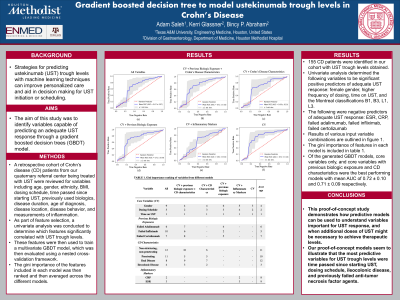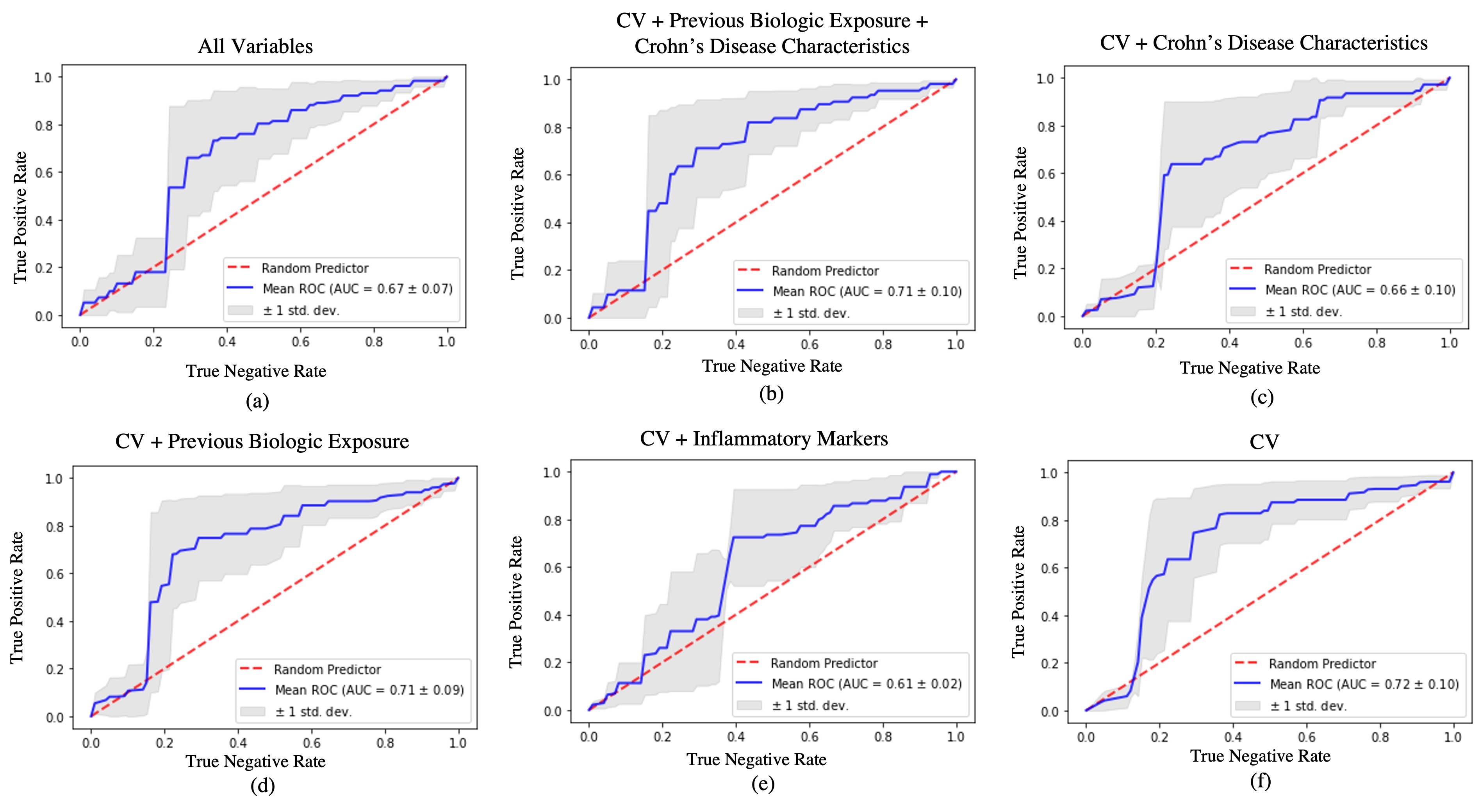Back


Poster Session C - Monday Afternoon
Category: IBD
C0376 - Gradient Boosted Decision Tree to Model Ustekinumab Trough Levels in Crohn’s Disease
Monday, October 24, 2022
3:00 PM – 5:00 PM ET
Location: Crown Ballroom

Has Audio

Adam A. Saleh, BS
Engineering Medicine at Texas A&M Health Science Center Medical School
Houston, TX
Presenting Author(s)
Adam A. Saleh, BS1, Natalia Miroballi, BS2, Rachel Stading, BS2, Kerri Glassner, DO3, Bincy Abraham, MD, MS, FACG3
1Engineering Medicine at Texas A&M Health Science Center Medical School, Houston, TX; 2Texas A&M Health Science Center Medical School, Houston, TX; 3Houston Methodist Academic Institute, Houston, TX
Introduction: Strategies for predicting ustekinumab (UST) trough levels with machine learning techniques can improve personalized care and aid in decision making for UST initiation or scheduling. The aim of this study was to identify variables capable of predicting an adequate UST response through a gradient boosted decision trees (GBDT) model.
Methods: A retrospective cohort of Crohn’s disease (CD) patients from our quaternary referral center being treated with UST were reviewed for variables including age, gender, ethnicity, BMI, dosing schedule, time passed since starting UST, previously used biologics, disease duration, age of diagnosis, disease location, disease behavior, and measurements of inflammation. Measurements of inflammation included albumin, CRP, ESR, lactoferrin, calprotectin, Harvey Bradshaw index (HBI), SES-CD, Rutgeerts, and intestinal ultrasound results. Null values were replaced with the mean of the rest of the feature. As part of feature selection, a univariate analysis was conducted to determine which features significantly correlated with UST trough levels. These features were then used to train a multivariate GBDT model, which was then evaluated using a nested cross-validation framework. The gini importance of the features included in each model was then ranked and then averaged across the different models.
Results: 155 CD patients were identified in our cohort with UST trough levels obtained. Univariate analysis determined the following variables to be significant predictors: female gender, dosing schedule, time on UST, ESR, CRP, failed adalimumab, failed infliximab, failed certolizumab, and the Montreal classifications B1, B3, L1, L3. Results of various input variable combinations are outlined in figure 1. The gini importance of features in each model is included in table 1. Of the generated GBDT models, core variables only, and core variables with previous biologic exposure and CD characteristics were the best performing models with mean AUC of 0.72 ± 0.10 and 0.71 ± 0.09 respectively.
Discussion: Within our study, this proof-of-concept study demonstrates how predictive models can be used to understand predictive variables for UST response, and when additional doses of UST might be necessary to achieve therapeutic levels. Our proof-of-concept models seem to illustrate that the most predictive variables for UST trough levels were time passed since starting UST, dosing schedule, ileocolonic disease, and previously failed anti-tumor necrosis factor agents.

Disclosures:
Adam A. Saleh, BS1, Natalia Miroballi, BS2, Rachel Stading, BS2, Kerri Glassner, DO3, Bincy Abraham, MD, MS, FACG3. C0376 - Gradient Boosted Decision Tree to Model Ustekinumab Trough Levels in Crohn’s Disease, ACG 2022 Annual Scientific Meeting Abstracts. Charlotte, NC: American College of Gastroenterology.
1Engineering Medicine at Texas A&M Health Science Center Medical School, Houston, TX; 2Texas A&M Health Science Center Medical School, Houston, TX; 3Houston Methodist Academic Institute, Houston, TX
Introduction: Strategies for predicting ustekinumab (UST) trough levels with machine learning techniques can improve personalized care and aid in decision making for UST initiation or scheduling. The aim of this study was to identify variables capable of predicting an adequate UST response through a gradient boosted decision trees (GBDT) model.
Methods: A retrospective cohort of Crohn’s disease (CD) patients from our quaternary referral center being treated with UST were reviewed for variables including age, gender, ethnicity, BMI, dosing schedule, time passed since starting UST, previously used biologics, disease duration, age of diagnosis, disease location, disease behavior, and measurements of inflammation. Measurements of inflammation included albumin, CRP, ESR, lactoferrin, calprotectin, Harvey Bradshaw index (HBI), SES-CD, Rutgeerts, and intestinal ultrasound results. Null values were replaced with the mean of the rest of the feature. As part of feature selection, a univariate analysis was conducted to determine which features significantly correlated with UST trough levels. These features were then used to train a multivariate GBDT model, which was then evaluated using a nested cross-validation framework. The gini importance of the features included in each model was then ranked and then averaged across the different models.
Results: 155 CD patients were identified in our cohort with UST trough levels obtained. Univariate analysis determined the following variables to be significant predictors: female gender, dosing schedule, time on UST, ESR, CRP, failed adalimumab, failed infliximab, failed certolizumab, and the Montreal classifications B1, B3, L1, L3. Results of various input variable combinations are outlined in figure 1. The gini importance of features in each model is included in table 1. Of the generated GBDT models, core variables only, and core variables with previous biologic exposure and CD characteristics were the best performing models with mean AUC of 0.72 ± 0.10 and 0.71 ± 0.09 respectively.
Discussion: Within our study, this proof-of-concept study demonstrates how predictive models can be used to understand predictive variables for UST response, and when additional doses of UST might be necessary to achieve therapeutic levels. Our proof-of-concept models seem to illustrate that the most predictive variables for UST trough levels were time passed since starting UST, dosing schedule, ileocolonic disease, and previously failed anti-tumor necrosis factor agents.

Figure: Figure 1: Impact of variable combinations on Gradient Boosted Decision Tree (GBDT) model’s area under the receiver operating characteristic curve (AUC). Graphs show mean (standard deviation) receiver operating characteristic (ROC) curves and AUCs for GBDT models with A) All variables B) Core variables (CV) plus previous biologic exposure and Crohn’s disease characteristics, C) CV plus Crohn’s Disease characteristics D) CV plus previous biologic exposure, E) CV plus inflammatory markers, and F) only CV. Core variables consist of gender, dosing schedule, and time on UST. Inflammatory markers consist of, erythrocyte sedimentation rate (ESR), and C-reactive protein (CRP). Previous biologic exposure includes adalimumab, infliximab, and certolizumab. Crohn’s disease characteristics includes disease location, and disease behavior (stricturing vs fistulizing).
|
Table: Table 1: Gini importance ranking of variables from different models. Final column averages the gini importance from each model combination before ranking them in order of importance.
Disclosures:
Adam Saleh indicated no relevant financial relationships.
Natalia Miroballi indicated no relevant financial relationships.
Rachel Stading indicated no relevant financial relationships.
Kerri Glassner indicated no relevant financial relationships.
Bincy Abraham: AbbVie – Consultant, Speakers Bureau. Bristol Myers Squibb – Consultant, Speakers Bureau. Eli Lilly – Consultant, Speakers Bureau. Janssen – Consultant, Speakers Bureau. Medtronic – Consultant. Pfizer – Consultant, Speakers Bureau. Takeda – Consultant, Grant/Research Support, Speakers Bureau.
Adam A. Saleh, BS1, Natalia Miroballi, BS2, Rachel Stading, BS2, Kerri Glassner, DO3, Bincy Abraham, MD, MS, FACG3. C0376 - Gradient Boosted Decision Tree to Model Ustekinumab Trough Levels in Crohn’s Disease, ACG 2022 Annual Scientific Meeting Abstracts. Charlotte, NC: American College of Gastroenterology.
